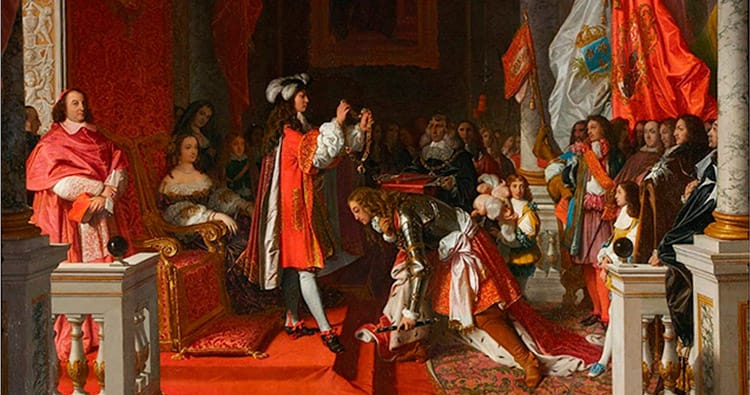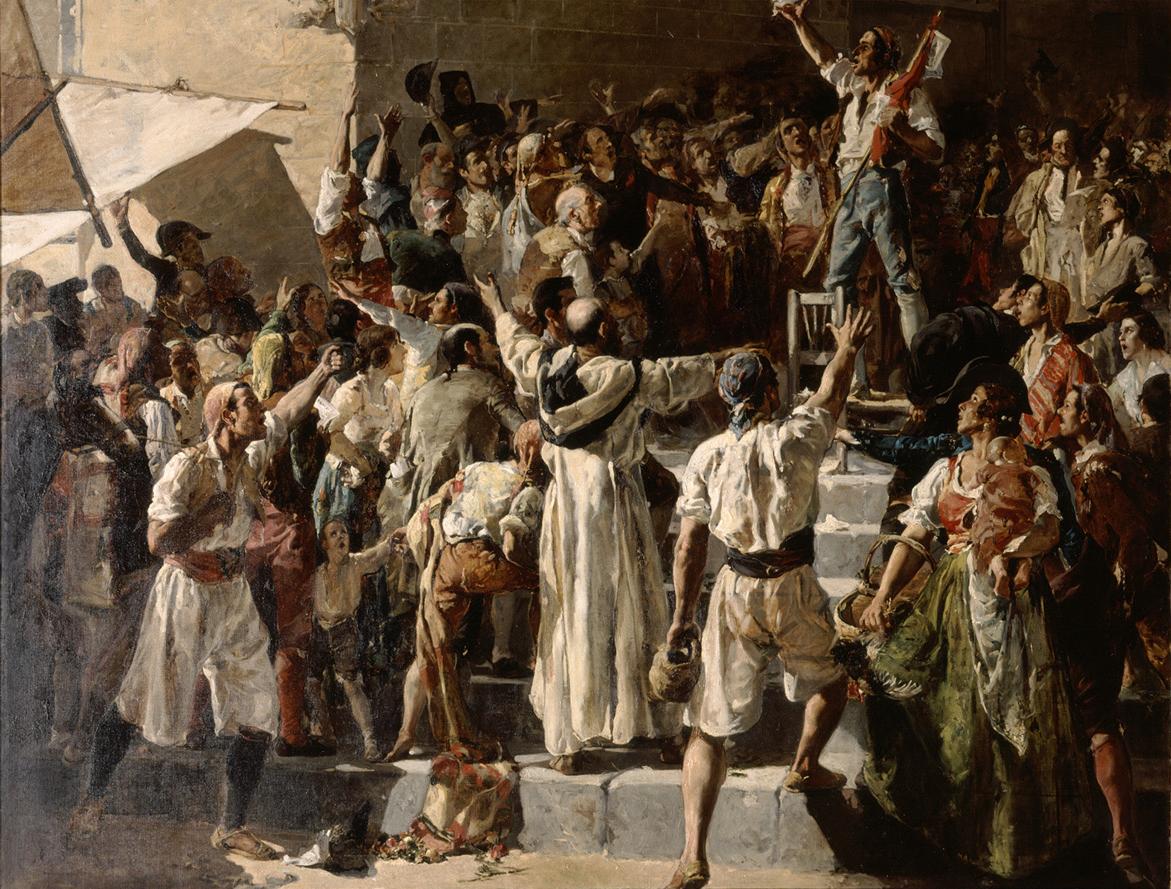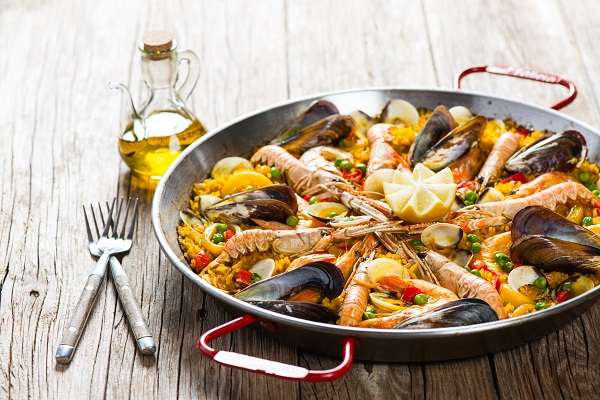Valencia is a region brimming with color and tradition. It’s a region full of different peoples, ideologies, and histories all which are conjoined into one magnificent place. Events such as the Las Fallas bonfire festival which sparks life into the history of Saint Joseph, and architecture such as the Valencia Cathedral which stands proudly as a symbol of Spanish pride imbuing wonder and excitement into the millions who visit every year. Its pride is one that yearns to be shared, both for the newly learned and the experts of the region. For those who wish to drive into the lesions from the culture’s rich past, there are dozens of opportunities from heritage sites to museums to be explored. Valencia has something for everyone, it does not discriminate when it shows its beauty, nor does it hide its history. So please do us the honor and come to Valencia, the “The Mediterranean As A City.”
Medieval History
By: Austin Walter
Valencia is one of the oldest cities in Spain and has experienced both highs and lows. From being a town of retired soldiers to the center of a foreign invader’s kingdom. To the challenge, a legendary hero of Spain conquered a thriving trade center. Then from its economic fall to its shift into the modern era Valencia has seen it all this city is one of learning and with a thriving history, one can only experience by being on its streets and exploring its markets. The Journey to Valencia is one worth taking and a college experience one will never forget. So let us open your eyes to the historical Valencia.
Valencia is one of the oldest cities in Spain. It is located on the Eastern Mediterranean and the Turia River. Valencia was established by the Romans after defeating Carthage during the Second Punic War. Consul Decimus Junius Brutus Callaicus settled veterans of the military of Lusatian leader Viriathus in 138 BC making this city also one of the oldest Roman cities outside of the Italian Peninsula. It was a thriving colony with a mint and extensive infrastructure such as baths, forms, and running water. but was razed by General Pompy after siding with Sertorius during the Roman Civil War. Christianity was also on the rise in the Roman empire and the same goes with Valencia deacon Vicentedttuesca, who became a saint to the faith after being tortured to death in 304 CE. The Roman Empire eventually declined and led the Germanic Visigoths to invade and take over Valencia in 413 CE.
During the Visgothic rule over Spain Valencia became important to the Catholic faith where it was a center. Valencia saw little development during the Visigoth period and eventually in 714 CE the Moors from the Muslim worlds took the city without a fight. The once Christian church in Valencia such as the Cathedral of Saint Vincent became a Mosque. Abd al-Rahman I became governor of Cordoba creating Al-Andalus Spain. Valencia was destroyed in 755 CE after wars with nobles and Rahman’s son rebuilt and ruled over the city. Valencia has an economic boom due to a large export of goods such as paper and ceramics during this time. Unfortunately, Al-Andalus Spain fell and Valencia became one of many Muslim Taifa kingdoms. Valencia grew, but Rodrigo Diaz de Vivar, a nobleman, and a legendary figure known as El Cid, laid siege to Valencia in 1092. After Rodrigo conquered Valencia in 1094 he ruled till 1099 dying in the defense of the city against the invading Muslim Almoravids. Valencia was in the Almoravid’s hands in 1102 and continued to be till 1171 when the new Almohads dynasty finally took Valencia after invading the peninsula 30 roughly years prior in 1145 the Almohads continued to rule for another century.
The Christian Reconquest began in 1238 under King James 1st of Aragon in which Crusaders sieged and took Valencia. Valencia was incorporated as a kingdom under the Crown of Aragon. The mosque was cleaned and turned back into a church under Catholicism. During the 14th century plaque such as the black death killed many Valencians and “Convencía” was falling apart leading to attacks, especially on Jewish and Muslim communities in the late 1300s and 1400s. Despite this, there was a massive economic expansion for Valencia expansion of the arts, industry, and a strong financial institution along with the largest population in the crown of Aragon. It led to things such as the La Lonja de la Seda which became a center for merchants around the world and all the money flowing in these bankers also helped fund Columbus’s voyage in 1492. This city was one of the centers of the Mediterranean with universities founded such as the University of Valencia and even the first printing press in Spain in 1474 was located in Valencia at the time. This prosperity would not last long after during the 1500s the Crown of Aragon set up colonies in the Americas, they shifted their focus on them taking trade away from the Valencian people causing an economic crisis. Resulting in a rebellion from the artisan guild in which King Charles the 1st had to fight from 1519-1523 eventually putting down the rebellion. In 1609 the crisis in Valencia got worse after the expulsion of Muslim people resulting in a crisis that bankrupted financial institutions and nobles. King Phillip IV’s wars and revolts such as the Catalan Revolt during this period from about 1630 till late 1650s created even more strain for Valencia after contributed financial aid.
Recreation
By Lauren Trent
Valencia has a wide array of fun recreational tourist spots. There are lots of historical landmarks to walk through. Cathedrals and museums galore. If that’s not your cup of tea there are a lot of outdoor based activities. There’s something here for everyone.
We have the lovely Valencia Institute of Modern Art (IVAM)It has a variety of art from the 20th century. The styles and eras of art vary in this museum from the pop art craze to the new figurative movement. This museum has it all in the European art market. There’s also a very cool historical portion of the museum you can visit. A section is completely underground and gives you a look at the real medieval Valencia city wall. (It was discovered there during the construction of the museum!!) If you like all things science Valencia has a wonderful science museum. This museum is all things interactive. Things to touch feel and see how science works all around you. It offers workshops and activities to keep you entertained. Three whole floors of fun scientific discoveries to be made. This is a trip the whole family can take and enjoy. To really feel and hear the sounds of Valencia there is the Palau de la Música auditorium. It has some of the best acoustics in all of Europe. It is located right next to the beautiful Turia Gardens and is parallel to the Turia River. It’s very beautiful with its glass dome (designed by Ricardo Bofill) The glass dome allows the music from within to be heard from the streets and shine light down on the concert halls.
Now if you are in Valencia to see historical landmarks. You are in luck because we have plenty to choose from. Starting off with the Valencia Regional Government Palace. Built in 1421 as the home for the Valencian. Autonomous government. It has 3 stories and has a different window style and structure on each floor. It did receive some Renaissance renovations in the 16th century by Juan Corbera. Or, if you want something even bigger to look at there’s the Valencia Cathedral. Built from the 13th to the 17th century with several additions added before it was completed. It is a beautiful example of Gothic architecture and the time period it comes from. There are so many amazing features to it. Such as the Capilla del Santo or the chapel of the Holy Chalice inside it is truly something spectacular to witness. It is considered the holy grail. The chalice that Christ had drank out of at the last supper. There is also the La Loja. Or the silk exchange. It was built in the 15th century to facilitate silk trading within the city of Valencia. Its columns inside are absolutely beautiful. Built to resemble a palm tree. The spiral and the outreaching arches on the top. The palm tree style is absolutely mesmerizing. It has 3 different sections including a tower and a courtroom originally used for verdicts within sea trading.
Modern History
By Caleb Sullivan
Valencia, a city sees throughout the ages as a unique regionally controlled pocket, that when compared to many of the other cities of Spain has evolved down many different paths. So great was their unique influence that Valencia was seen as a seat of power for many different dynasties. However, in the early 18th century the war of succession, which was sparked due to King Charles the second not having an heir on his death, forced Valencia to take a side. Choosing to take the side of the contender Archduke Charles who was from Austria resulted in a critical defeat in 1707 and the writing of the Nueva Plant Decree which proved devastating for Valencia. This was because Valencia was forced to relinquish their local charter, causing their unique governance status to be revoked.

Looking past the events of the Nueva Planta, and twords more recent historical events, Valenica has had a painful history with outsiders, and those influencing its culture who are not Spanish. During Napoleons conquest of the Iberian Peninsula in the early 19th century starting in 1807. Valencia stood against Napolean’s tyrannical slaughter on May the 23rd, 1808, as civilians rushed out onto the streets determined to drive away the foreign invaders.

After Napolean’s reign was crushed Valencia saw greater opportunity to expand, demolishing previous medieval architecture as well as war scared buildings to make room for new marvels such as the Mercado de Colón. Within the 20th century, Spain was wracked with civil war and making no exception was Valencia. Becoming the capital of the Republic, Valencia stood as a proud defender of democratic and libertarian views against Francos’s authoritarian regime. 1939 marked the end of their noble defiance, as Franco’s army marched on Valencia and for the next 40 years suffered under his rule. But hope remained, as in 1975 Francos death meant the reinstitution of Valencian culture into the region, with a notarized constitution in 1978 based on democracy and local freedoms. Valencia is now focused on bringing back traditions long lost and life without the control of foreign entities.
Savor the Flavor of Valencia
By Dustin Woodall
Bienvenidos a Valencia! Nestled along the picturesque Mediterranean coast, this vibrant city offers more than just a breathtaking landscape and rich cultural history. Imagine immersing yourself in a world where ancient traditions meet modern innovation, and every cobblestone street is a testament to a culinary adventure waiting to be explored. If you’re a U.S. college student or professor with a taste for the extraordinary, consider Valencia as your next destination for a study abroad experience. In this blog, we’ll delve into the city’s unique charm, focusing on the irresistible culinary delights that make Valencia an unparalleled destination for academic and gastronomic exploration.
A Taste of Tradition
Valencia’s culinary scene is a melting pot of influences, reflecting the city’s diverse history. From the bustling markets to the quaint family-owned restaurants, you’ll encounter a spectrum of flavors that have withstood the test of time. Dive into the heart of Spanish cuisine with iconic dishes such as paella, a savory rice dish infused with saffron and an array of fresh seafood. Let your taste buds dance to the rhythm of traditional tapas, small plates bursting with flavors that encourage communal dining and lively conversations.

The Mercado Central Experience
For a true taste of Valencia’s culinary vibrancy, a visit to the Mercado Central is a must. Imagine a bustling marketplace where local vendors showcase an abundance of fresh produce, fragrant spices, and artisanal products. It’s not just a shopping excursion; it’s an immersion into the essence of Valencian life. As a student or professor, exploring the market becomes a delightful classroom, offering lessons in cultural exchange, language, and the significance of local ingredients in Mediterranean cuisine.

Culinary Innovation Meets Tradition
Valencia is not only about preserving culinary traditions; it’s also a hub of innovation, where avant-garde chefs are redefining Spanish cuisine. Indulge in the contemporary culinary scene, where traditional recipes are given a modern twist, resulting in a fusion of flavors that captivate the senses. Your study abroad experience in Valencia won’t just be an academic endeavor; it will be a culinary odyssey that broadens your palate and challenges your preconceptions about food.
Building Bridges through Shared Meals
Food is more than sustenance in Valencia; it’s a language of its own. Picture yourself sharing a meal with locals, engaging in conversations that transcend cultural boundaries. Establishing a study abroad program in Valencia opens the door to meaningful connections, forging friendships over shared plates and discovering the universal language of gastronomy. Professors, envision your students gaining a deeper understanding of Spanish culture through the lens of its cuisine, fostering a truly immersive and transformative educational experience.
Valencia beckons with open arms, inviting students and professors alike to embark on a journey of academic discovery intertwined with the irresistible allure of its culinary treasures. From the traditional flavors of paella to the delicious new twists of modern chefs, Valencia offers a feast for the senses. Consider this city not just as a study abroad destination but as a gateway to a world where education and cuisine converge, creating memories that will remain long after your academic journey comes to an end. Embrace the flavors of Valencia, and let your academic adventure be seasoned with the richness of Spanish culture and cuisine. ¡Buen provecho!
Further Information
Britannica, T. Editors of Encyclopedia. “Valencia.” Encyclopedia Britannica, November 15, 2023. https://www.britannica.com/place/Valencia-Spain.
Burns, R. Ignatius. “A Mediaeval Income Tax: The Tithe in the Thirteenth-Century Kingdom of Valencia.” Speculum 41, no. 3 (1966): 438–52. https://doi.org/10.2307/2851040.
Holliday, Will. “Hispania-Roman Spain, Visigothic Spain, Al-Andalus Spain, Spain 11th and 12th century, and 13th and 14th Century Spain, and Spanish 15th and 16th century .” History of Spain. Lecture presented in Farmville, at Longwood University, 2023.
Lindeman, Katherine. “Fighting Words: Vengeance, Jews, and Saint Vicent Ferrer in Late-Medieval Valencia.” Speculum 91, no. 3 (2016): 690–723. http://www.jstor.org/stable/43884297.
Shubert, A. , Viguera, . María J. , Ginés, . Juan Vernet , Koenigsberger, . Helmut Georg , Richardson, . John S. , Smith, . Catherine Delano , Carr, . Raymond , O’Callaghan, . Joseph F. , Harrison, . Richard John and Rodriguez, . Vicente. “Spain.” Encyclopedia Britannica, November 19, 2023. https://www.britannica.com/place/Spain.
Trent, Lauren. “La Lonja De La Seda.” History of Spain.Presented in Farmville, at Longwood University, 2023.
Valencia The Offical Website, “History of Valencia.” València Green Capital 2024, https://www.visitvalencia.com/en/what-to-do-valencia/valencian-culture/history
The Royal Hampshire Regiment, “The War of the Spanish Succession.” The Royal Hampshire Regiment, https://www.royalhampshireregiment.org/about-the-museum/timeline/war-spanish-succession/#:~:text=The%20War%20of%20the%20Spanish%20Succession%20(1701%E2%80%931714)%20has,II%20of%20Spain%20in%201700.
Espana spain information. 2023. Valenica The meditranean as a City. Espana . Accessed November 20th, 2023. https://www.spain.info/en/destination/valencia/.
“Central Market.” Visit Valencia, https://www.visitvalencia.com/en/what-to-do-valencia/valencian-culture/monuments-in-valencia/central-market. Accessed November 20, 2023.
“The History of Paella.” The Paella Company, https://www.thepaellacompany.co.uk/history.html. Accessed November 20, 2023.
“Gastronomy of the Region of Valencia.” Spain.info, https://www.spain.info/en/gastronomy/region-of-valencia-cuisine/. Accessed November 20, 2023.
Virtual Tours
La Lonja de la Seda de Valencia (UNESCO/NHK) – YouTube: Virtual tour of La Lonja de la Seda gives a short look at both the exterior and interior of the heritage site.
VALENCIA City Guide | Spain | Travel Guide – YouTube: Compete Tour of Valencia gives an insight into its history as well as the hottest spots and best times to go for a study abroad trip.
